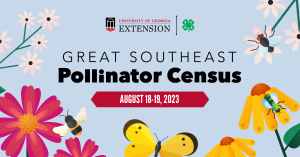Heather N. Kolich, ANR Agent, UGA Extension Forsyth County
Sometimes, researchers ask questions that require a lot of data to help formulate answers. Questions like:
- Where are Eastern bluebirds nesting?
- How plentiful are pollinators in Georgia?
- Where are invasive species showing up?
- How far did the earthquake reach?
Collecting this type of data over large geographic areas would be challenging for a single researcher. But if a lot of people spend a few minutes in their area making observations and reporting, the collective effort generates an abundance of data to help answer big science questions.
Citizen science, also called participatory science, is helping universities and environmental agencies answer questions like these and do other things, like monitor streams for pollution, to address real-world issues. Many projects are suitable for both youth and adult participants.
Participating in some citizen science projects, such as the Great Southeast Pollinator Census is as simple as counting pollinators for 15 minutes and uploading your data online. Other projects require some training, like learning how to identify birds or learning to test stream water samples for bacteria.
Citizen science projects may be on-going or scheduled to gather data on specific dates or for a particular season. Below are examples some easy-entry projects for the summer.

Atlanta Firefly Project – Open to all counties, this project originated as a graduate research project in 2021 and continues through the Odum School of Ecology at the University of Georgia. It may help answer questions such as how light pollution and different landscape practices affect firefly populations. To participate, people spend about 30 minutes relaxing in their yard or other outdoor space while counting firefly flashes. Participants are asked to monitor during two evenings in June and two evenings in July, then upload data after each session through a phone app. Learn more.

Bat Roost Monitoring – The Georgia Department of Natural Resources offers another opportunity to serve science while relaxing outdoors and enjoying Georgia’s natural night life. Georgia’s 16 species of bats provide important insect control services, but they face survival challenges from habitat loss and disease. Bat roost monitoring helps Georgia DNR estimate bat populations around the state. To participate, first figure out where bats are roosting. Then, set up your lawn chair near the roosting site about 30 minutes before sunset, get comfortable, and open the Georgia DNR bat monitoring app. Start counting when bats begin to emerge from the roost. See https://georgiawildlife.com/bat-roost-monitoring.

Great Southeast Pollinator Census – Another UGA project, this citizen science effort recently expanded to include other southeastern states. It takes place each August over a Friday and Saturday, during which participants select a landscape flower or flowering plant to observe for 15 minutes. During the observation window, participants use a pollinator identification check sheet to record the number of times pollinators in different categories (i.e., large bee, small bee, wasp, fly) visit the flower they are watching. Resources include materials to help teachers use the program as a class or school project. See https://ggapc.org/count/.

NestWatch – A national bird monitoring program developed by Cornell University, NestWatch engages citizen scientists to gather information that helps track trends in the reproductive biology of birds. After learning the program protocols, nest watchers collect and report data regarding the location of a nest, the species of bird nesting, and what is in the nest (i.e., nothing, eggs, hatchlings) at each of 5-10 brief observational visits during the breeding season. See https://nestwatch.org/.
If enjoying the wonders of nature, helping conserve natural resources, and having fun aren’t incentive enough, here’s another reason to become a citizen scientist: Spending time in nature has several health benefits. Exposure to nature improves mental and emotional health and cognitive function, lowers stress and blood pressure, and lifts your mood.